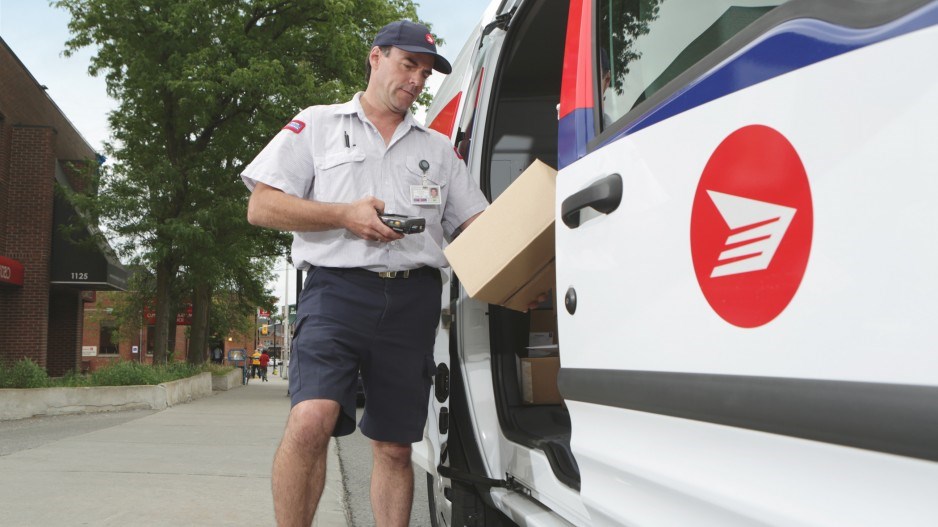Canadian businesses might need to start making alternative arrangements to snail mail and Canada Post parcel delivery as the prospect of a July shutdown of national postal services looms.
Canada’s postal workers will be in a legal strike position on July 2, but a union leader says posties might not even get the chance to take a strike vote.
“Every indication is that they’re looking toward locking us out in July,” said Mike Palecek, national president of the Canadian Union of Postal Workers (CUPW), which represents 50,000 postal workers. “Canada Post has come to the table demanding major cuts to everything from benefits to pensions to job security.”
The last lockout in 2011 followed rotating strikes before postal workers were legislated back to work.
Each time there is a strike or a lockout, Canada Post loses business customers, sometimes for good, said Richard Truscott, western Canadian vice-president for the Canadian Federation of Independent Business (CFIB).
“Canada Post and its workers are shooting themselves in the foot.”
Many small businesses rely on Canada Post for parcel delivery, billing, invoicing and other services. Truscott said CFIB member surveys show 61% of respondents say Canada Post delivery services are very important to their operations.
But when the service becomes unreliable, Canada’s national mail service loses business customers to couriers and electronic billing and invoicing.
“It seems every time Canada Post operations are suspended, or there is a strike, that the corporation bleeds a little bit more, that fewer and fewer small businesses are using their services,” Truscott said. “They vote with their feet, and once they experience a different way of doing business, some of them stay. That means Canada Post is losing long-term customers to other service providers.”
The main bones of contention in the current round of collective bargaining include job security, proposed changes to pension plans and pay equity among urban and rural carriers. CUPW is framing the last as a gender pay equity issue.
Rural carriers are paid less than their urban counterparts, Palecek said. He added that while 70% of urban postal workers are male, 70% of rural carriers are female.
“This is a predominently female bargaining unit. They make about 28% less than the predominently male bargaining unit doing the same work. We let them [Canada Post] know that they’re in violation of Canada’s pay equity legislation on this.”
As for pensions, Canada Post wants to move from a defined pension plan for its workers to a defined contribution plan. Defined pensions assure workers of predetermined pension benefits; benefits under a defined contribution plan are based on the pension fund’s market performance. Truscott said defined pension plans are expensive and unsustainable.
“There’s two elephants in the room. One is they need to deal with their unfunded pension liabilities and the overall cost of the labour, and at the very least not be increasing the price for some of their services.”
A lockout could raise the public’s interest in an ongoing federal government review of Canada Post operations. Among the issues being reviewed is door-to-door mail delivery. Under the Stephen Harper Conservatives, Canada Post had begun converting residential customers from door-to-door service to community mailboxes.
Those conversions, which were expected to save Canada Post $400 million to $500 million annually, were halted by the new Liberal government.
Whether it will be permanently halted is just one of the questions being addressed through public consultation.
But Palecek said more conversions to community mailboxes are not needed.
“Canada Post is making profits. It just reported a first-quarter profit of $44 million. We really don’t see the need to make any cuts given that we continue to make healthy profits.”
But profits are up, in part, because of the conversions that have already taken place. A total of 830,000 homes had been converted to community mailboxes by the end of 2015, netting Canada Post a savings of $80 million.
Annual financial statements also paint a different picture than the most recent quarterly financials about Canada Post’s longer-term financial position. In 2015, Canada Post’s before-tax profits were down 67.5%, from $194 million in 2014 to $63 million, and the Canada Post group of companies’ profits were down 50%, from $269 million in 2014 to $136 million .
While its parcel delivery business is growing, thanks to e-commerce, Canada Post’s traditional mail service is in long-term decline.




